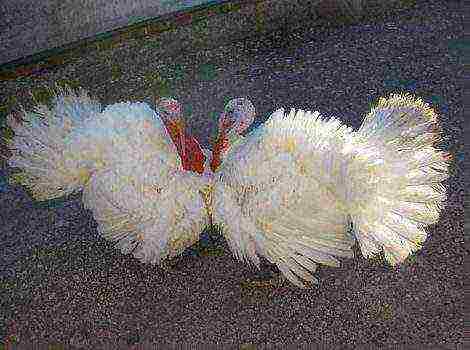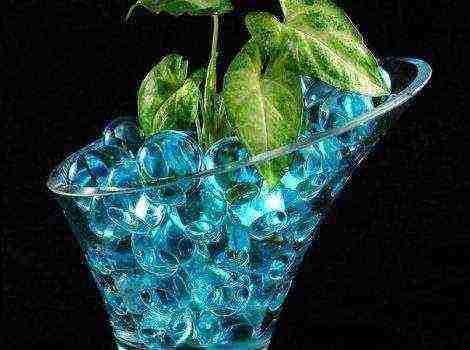Content
Many put onions in jars of water so that they can feast on the green arrows. However, a lot of dishes do not fit on one window, and it is inconvenient to force all the space.
What to do if there is a minimum of space, and you want to get more harvest? There is an original way. You can grow onions on a windowsill in a plastic bottle, making a convenient and cute design out of it. What is needed for this?
Minimum conditions for growing bottle onions
Onions in a bottle are unpretentious to growing conditions. For normal growth, he only needs a lighted window sill and the absence of sub-zero temperatures.
There is no need to feed the plant with fertilizers, because the bulb itself contains a sufficient supply of nutrients.
back to contents ↑ Soil
The onion is not at all picky about the composition of the earthen substrate. For its cultivation in plastic bottles, ordinary soil is most often used. You can buy soil from a gardening store or dig up in your garden.
However, in the latter case, the soil will have to be disinfected by calcining it.
You can plant onions in a bottle on a windowsill on a feather not only in the ground, there are alternative ways.
For example, you can use toilet paper or sawdust. But such an environment is much less nutritious than soil, although many home gardeners have successfully applied this method in practice.
The disadvantage of these materials is the possibility of mold formation. Another disadvantage of toilet paper is not an aesthetic appearance, because you can see everything through a transparent bottle.
However, when the green feathers grow and rise up, they hide an unsightly sight.
The next alternative to bottled earth is foam rubber, its advantage is that it does not get moldy, unlike sawdust and paper. It is cut into small pieces in random order and the space between the bulbs is filled with it.
The advantage of this method is the moisture content and air permeability of the foam material. Alternatively, instead of soil, you can fill a container with onions with vermiculite or coconut substrate.
back to contents ↑ Container and watering
Windowsill onions can only be grown in bottles that have been used to store food and drinks. Chemical containers store toxic residues for a long time, so they are unsuitable in this case.
For forcing green onions, bottles with a volume of 3-6 liters are usually taken, although both 1.5-liter and 10-liter containers are quite suitable.
All onion care consists in watering and removing excess liquid from the pan. Watering is not necessary often, but with plenty of water.
The green onion can also be additionally sprayed with a spray bottle.
Remember! The less water the plant receives, the more bitter the feathers will taste.
back to contents ↑ How to prepare planting material?
For planting, choose small or medium onions with a diameter of at least 3 cm; it is better not to take onion sets that are too small.
Of course, you can do without preparing the bulbs, but the result will not be so amazing.
In order for the onion feathers to grow faster, first the bulbs should be soaked for at least 6 hours in warm water, preferably at the same time the spray of the aquarium compressor should be lowered into the dish with the liquid.
So the planting material will be saturated with oxygen and germinate faster.
Before planting in bottles, the bulbs must be cut off a little in the neck area, and this is a prerequisite, in contrast to soaking and air saturation.
back to contents ↑ Preparing a plastic bottle for onions
- The neck of the bottle should be cut off so that the onion can easily pass through.
- Now let's take care of the holes on the side of the bottle, their diameter should be slightly smaller than the diameter of the bulbs, so you need to measure everything carefully. The holes are made in a checkerboard pattern, but they do not start from the very bottom of the bottle, so that after watering, the accumulated liquid does not pour out through them. The holes are cut with nail scissors or burned with a red-hot iron object, but the latter option is unsafe for health.
- Sometimes it is difficult to cut holes in an empty bottle due to the plastic flexing a lot. For convenience, fill the container a third with water and put it out in the cold. When the liquid is frozen, the bottle will be less prone to deformation.
- Remember to punch small holes in the bottom of the bottle to drain excess water. In addition, the container must be placed on a pallet (plate, dishes, etc.)
back to contents ↑ Planting onions in a plastic bottle
After preparing the bottle structure, we proceed to planting the onion. The whole process must be done after covering the surface of the table with paper or cloth, since there will certainly be dirt from the combination of earth and water.
We fill up the soil to the first level of holes, tamp and put an onion near each hole so that its cut looks out of the "window".
Then again you should fill up the soil until the next row of holes and put the bow, then the sequence is repeated.
When the bottle is filled with earth and there are no free holes left, we also plant the bulbs on top.
When the multi-storey onion “house” is ready, we put it on a pallet and water it abundantly. We put the structure on a lighted window.
In a week you will see the cherished green feathers, and a couple of weeks later, the "house" with an onion will resemble a cactus. It will become not only a source of vitamins, but also a decorative element of the room.
Decide at least once on this experiment with an onion and a bottle, you will not regret it!
Similar articles:
.
The garden on the windowsill is a favorite hobby of city housewives throughout the year. Modern craftsmen are improving technology, allowing the cultivation of popular vegetable crops. In a short review, we'll talk about how to grow onions in a plastic bottle.

Growing onions in a bottle is an easy way to get greens at any time of the year.
Features of cultivation
Breeding greens on a windowsill is not unusual, but there are a few important things you need to know to get quality leeks. In order to get the most out of the planting material, you should worry about fertile and disinfected soil in advance. We recommend purchasing land in a specialized store. Then your crop will not be attacked by parasites and pathogens.
Sometimes, instead of soil mixture, substitutes are used - sawdust or toilet paper. They are very easy to use and do not stain everything around. But more attention is required when watering, since excess moisture will spoil the seed, and if there is a lack of water, there will be no full return. Remember: you cannot take sawdust filler for animal trays for planting onions. Products are processed with chemicals that turn into greens.
When is the best time to land at home? Subject to the rules for growing leeks, the horizontal bed is cultivated throughout the year. The hostess does not need to worry about buying green onions - they will always be at hand. Adequate light and regular watering are all the requirements of an unpretentious plant. In winter, the bed develops on a light windowsill, and in summer it is recommended to put it on a balcony or sunny loggia.
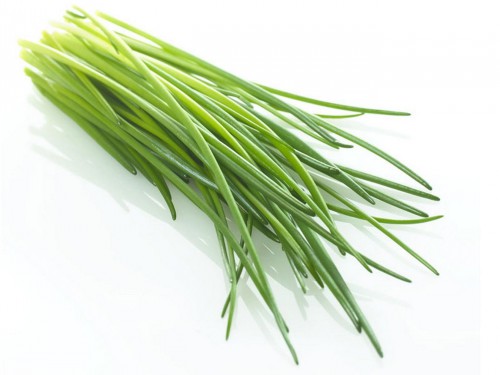
Green onions are quite expensive in winter, and growing them on their own will not be a hassle.
Materials (edit)
How to make a structure for growing green onions at home? You will need:
- a clean plastic bottle (2 or 5 liters);
- the soil;
- planting material;
- water;
- sharp object for making holes.
Remember: use the container only after food. Building mixtures, fuels and lubricants are not completely washed out, therefore they are not suitable for growing green spices. Rinse and dry bottles thoroughly before use.
For planting onions, choose small, elastic heads, without traces of rot and mold. Defects, pathogenic bacteria on the vegetable will infect the soil and destroy healthy specimens.
A special seedling is also used, but it quickly depletes and needs to be replaced. Large bulbs take up a lot of space in the container and are therefore not ergonomic.
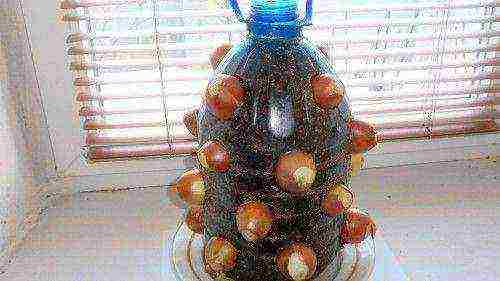
Onions planted in a bottle
Instructions
To plant onions in a bottle, you need to cut off the neck and make holes on the sides of the future garden with sharp scissors. Professionals recommend soldering holes with a rounded hot object - an old soldering iron or a heated piece of metal. Remember: through gaps that are too large, the heads of the planting material will fall out and wet soil will seep.
A simple technique will make the process of cutting holes easier. Pour water into the bottle, approximately 1/3 of its volume. Then put the container with water in the frost. After the water freezes in it, they start cutting holes.
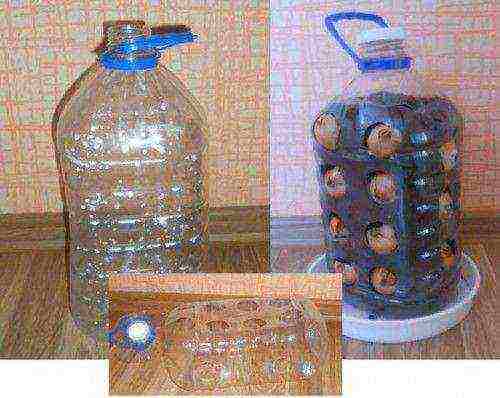
Preparing a bottle for planting onions is a snap.
Nutrient soil is poured onto the bottom of the bottle to the level of the lower holes, then they begin to insert planting material into the holes. The growth point looks outward - the bulbs act as corks and do not allow the earth to fall out. Grind the holes with a layer of soil to the next level, water and repeat the whole procedure again to the very top.
The resulting garden bed is placed on a pallet or in a pot so that the liquid does not spill out and stain everything around it. Depending on the size of the container, an old bowl or small bucket will work well. After watering, water should not be allowed to stagnate, so always pour out.
Greenery will begin to revitalize when there is enough sun. A bright window sill or balcony is a suitable place for cultivation. If all the conditions have been met, then in a week the first green feathers will appear. Moisturizing on time will make the seasoning taste less pungent, so remember to water and sprinkle the onions in the bottle.
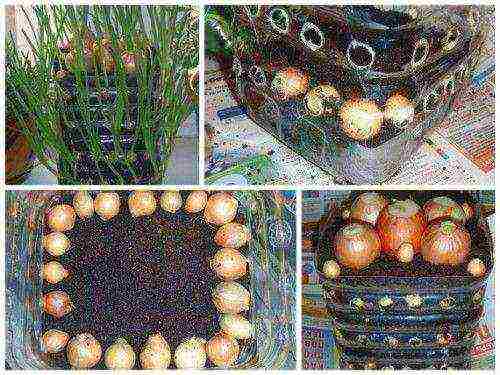
Onion planting options
Pros and cons of the method
Growing greenery at home has been practiced for a long time and over the years it has evolved from bulbs in jars to such complex structures that take up a minimum of space. A horizontal bed allows you to grow a lot of leeks in a small area. If you equip a useful sunny space on the windowsill and balcony, then this plantation will bring additional income to its owner.
This technique requires a minimum investment, since plastic bottles are available in every apartment. Depending on the needs, both 1.5 l and 10 l containers are used. When grown in soil, onions throw away feathers for a long time, unlike cultivation in water. The appearance of the structure is more presentable than glass jars on the windowsill.
The disadvantages of this technique include painstaking and accuracy in the manufacture of a container for growing greenery at home. It is necessary to compare the sizes of the planting material with the holes, and any mistake forces you to take a new container. Cutting holes is carried out with sharp objects, so remember the safety rules. The presence of a small diameter metal rod simplifies the procedure, but you can get burned.
The process of making a structure is very messy, since you have to contact with earth and water.In order not to stain the window sill, monitor the liquid level in the drain trays. Watering is carried out slowly so that the soil has time to gradually soak.
Cultivation in toilet paper and sawdust is less of a problem, but such mixtures are less nutritious and quickly deplete the bulbs.
Growing greenery in an apartment is a great way to provide family with vitamins with minimal financial costs. By adhering to our recommendations, you will create not only a modern bow design, but also a great decor element.
Subscribe Be aware of new products on our site
And we will go the other way ... Or - how to save space on the kitchen windowsill by growing onions in a plastic bottle.
For most people, the first consciously grown plant is a bulb, planted in a jar or glass. Until now, the kitchen windowsills of grandmothers and mothers are decorated with a variety of dishes - faceted glasses, jars of mayonnaise, containers and trays of various food, in which bulbs of various sizes and varieties flaunt, pulling their bright green feathers to the light. The picture, of course, is pastoral and touching, but ... This is the 21st century. The progress of mankind is striding by leaps and bounds, and after it the vigilant trot and vigilant ingenuity of the Russian man hastened, which brought him to the idea - green onions in a bottle.
Neither a German, nor a Dutchman, nor a Czech, or a Frenchman would ever have guessed how to make good use of an absolutely waste, disposable material - an empty plastic bottle. And all because they have containers on the streets to collect plastic waste. And we do not stand. And it's a pity to throw it away.
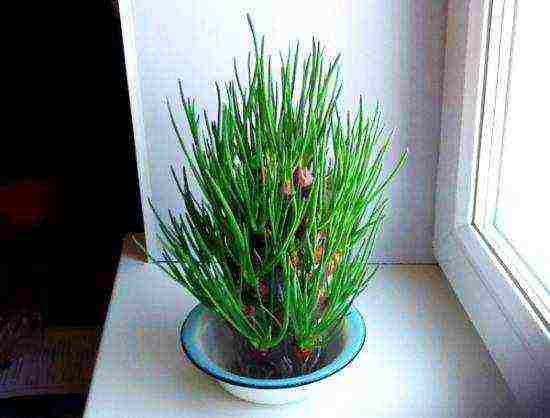
Fast, clean, safe ...
The topic of our conversation today will be to grow onions in a bottle. Who first came to mind and in what city to make a miniature vertical garden out of a plastic bottle is not known. But the idea turned out to be so attractive and tempting that there are a lot of followers of growing onions in plastic bottles.
Let's start with the material needed to make a mini garden bed. Naturally, this is a plastic bottle with a volume of at least 1.5 liters, preferably without transverse reinforcing profiles on the surface. The best option for planting large bulbs would be a five-liter plastic bottle for drinking water.
Preparing the bottle for planting the bulbs consists in making holes in the wall of the vessel approximately corresponding to the diameter of the planting material. Since growing onions on a feather on window sills is the prerogative of mainly representatives of the older generation, then, accordingly, the advice that Internet is full of.
Someone advises to cut with scissors - an occupation not for the faint of heart. Since then, the advice has been wandering around the open spaces of the Runet: to melt holes with a red-hot metal rod. People! Never do this!
The harmless plastic used to make bottles is for cold food only. When heated to its melting point or higher - to its flashpoint, it releases deadly phosgene and dioxin! Having made twenty holes in this way, you can get poisoned.
It is much easier to pour water into a bottle, lower five or six pieces of polymer packing cord and close the lid and place it in the fridge freezer or in the cold until it freezes completely.
Frozen water will prevent the bottle from deforming during operation, the ropes inside - crumbling ice into small crumbs. Next, an electric drill (screwdriver) is taken with a type-setting drill for wood (or a similar crown) with a diameter slightly less than the size of the bulbs and the required number of holes is drilled in a checkerboard pattern. Fast, clean, environmentally friendly.After that, we place the bottle in a bathtub or sink under warm water so that the ice melts faster. The container for planting is ready.
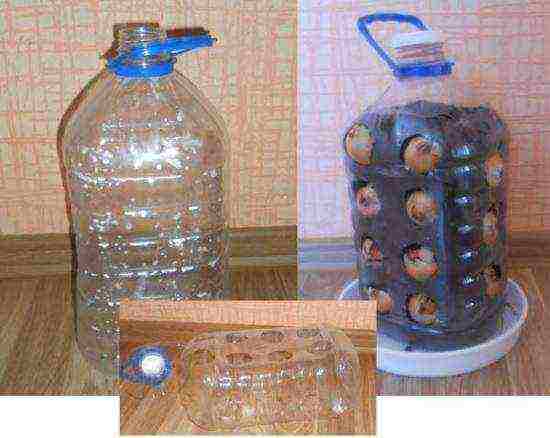
Soil preparation ... Is it needed?
The mass of enthusiasts for forcing green onions in a bottle at home cannot get away from burying the onion in the ground. To do this, it is advised to gradually fill the bottle with the cut off neck with earth, gradually inserting the bulbs into the holes so that their upper part protrudes outward and further, sprinkling with earth layer by layer, completely fill the bottle with onions and earth.
There is no practical need to use the soil for forcing onions on a feather.
A bulb - even a small sample of d-3-4 cm, contains a sufficient amount of nutrients to ensure the growth of a feather 20-25 cm long in the presence of moisture.Therefore, instead of soil, we recommend using not toilet paper or sawdust as a filler - in them mold will certainly start, and ordinary foam rubber, cut into small pieces of arbitrary shape: about 2x2 cm. They will fill the voids between the bulbs.
The advantage of foam rubber is that it is a very moisture-absorbing material and at the same time, breathable. The onions in the bottle will be constantly hydrated and will be able to breathe calmly.
One watering per week is enough for the harvest to be ready for harvesting 20-25 days after planting.
Instead of foam rubber, you can use coconut substrate (4 kg briquette - 86 rubles), perlite or vermiculite (3 kg package. From 70 to 550 rubles) to fill the gaps between the bulbs.
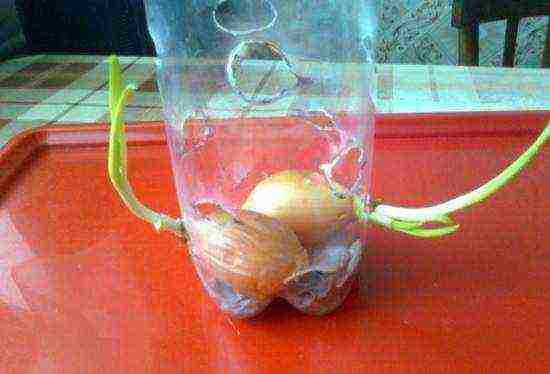
Preparation of planting material
Housewives who grow onions on their windowsills do not think about preparing planting material. The first onion that comes across is stuck into the water and it grows by itself.
People who grow green onions on an industrial scale must prepare the bulbs before forcing the green feather.
The preparation process is not difficult and not time consuming. Selected bulbs, as a rule, a sample of d-3-5 cm. Are soaked for 6-12 hours in water at a temperature of 25-30 C. In this case, intensive aeration is carried out. The process is called bubbling. Promotes the "awakening" of the bulbs and faster regrowth of the feather. At home, it is enough to stir the onion in a container several times during bubbling, or lower the compressor spray for aquariums (whoever has it) into it. After bubbling, the onion is trimmed from the neck so that the green point of the sprout is visible. The onions are ready for distillation.
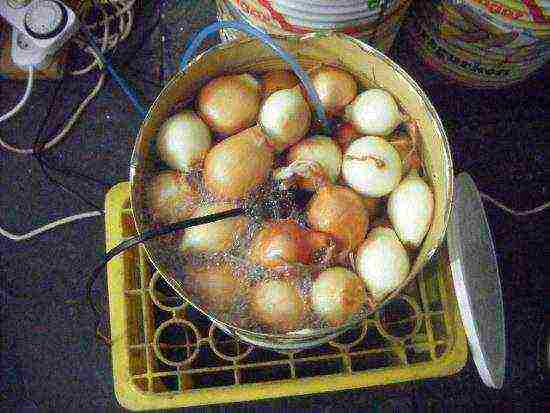
Planting care
Maintenance, as such, is not required, except for regular watering - rarely, but abundantly! During the forcing of the feather, you can feed the onion with a solution of mineral fertilizers. But this is not for everybody. Green onions grown in a plastic bottle on a windowsill are an exceptionally sustainable product. There is no need to spoil it with any fertilizers or dressings. The only sustainability problem can arise when growing onions in the kitchen for big fried lovers. Vapors of frying oil evaporating from the frying pan settle on the onion feather and are actively absorbed by plants, saturating them with carcinogens. Concentrations are insignificant, but suspicious natures are a reason to think.
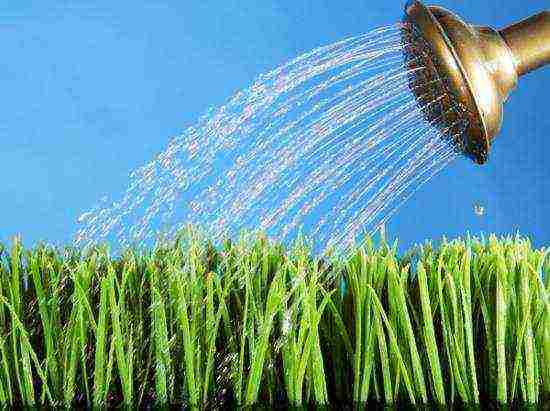
Conclusion
Forcing greens at home, be it onions, parsley, dill, lettuce or basil, is traditional for the vast majority of culinary experts around the world. Purchased greens in winter are expensive, and their origin and degree of saturation with nitrogen fertilizers are not known. Self-cultivation is a penny. A few plastic bottles are enough to always have fragrant, vitamin-rich greens on your table - a great addition and decoration to any dish.
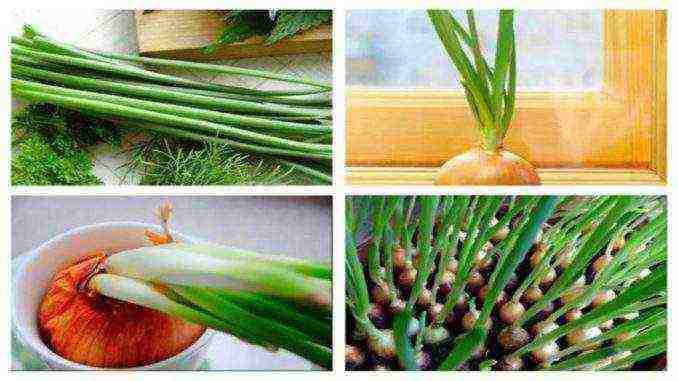
If there is no summer cottage, then you can arrange a garden in your own apartment.
It is worth knowing how to grow onions on a windowsill.
Getting tasty green feathers is pretty easy.The plant is unpretentious, so you can cope with it even without special skills.
How to choose bulbs
The advantages of growing onions at home on the windowsill are beyond doubt. You can eat a healthy vegetable even in winter, when the body especially needs vitamins. You can be sure that the product is not treated with harmful chemicals. In addition, if you want to make a delicious salad, there is no need to run to the store. The bow is always at hand.
You can grow green onions on a windowsill in soil or in water. The methods are equivalent, they do not affect the speed of obtaining the harvest and its quantity. Therefore, you need to choose the one that is more to your liking.
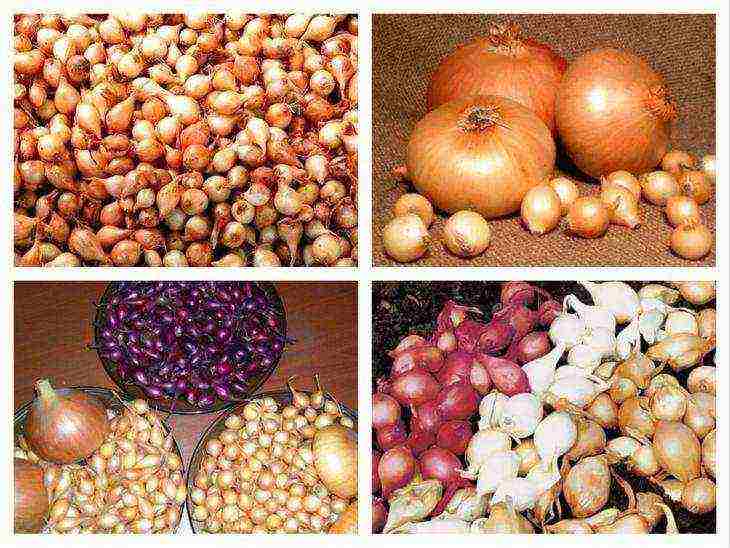
You should start by selecting and preparing the bulbs. Onions are most often grown. But other varieties are also suitable for home: onion sets, chives, leeks. Moreover, sevok or chives can be grown from seeds, if there is such a desire.
It is best to use already sprouted bulbs to get feathers. That is, it is easier to do forcing from about January, when the vegetable comes out of a state of dormancy.
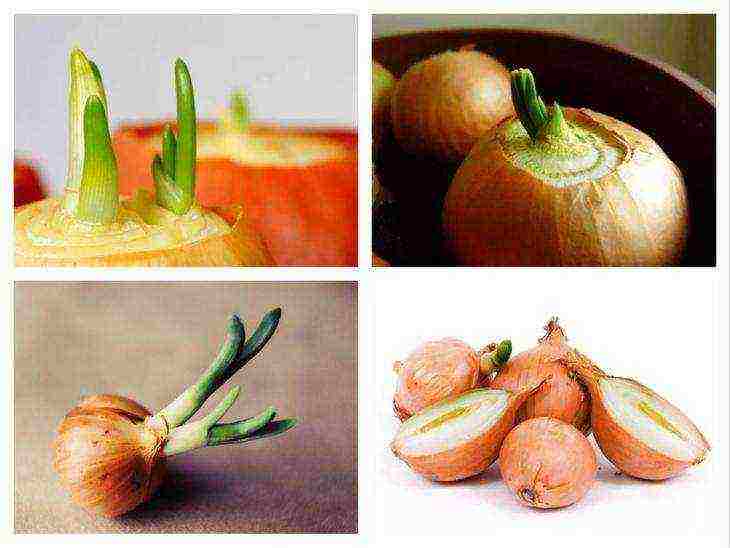
But even before that time, you should not deny yourself this source of vitamins. You just need to adhere to some rules:
- Choose medium-sized bulbs.
- In the fall, they should be placed in a cool place such as a refrigerator. This will speed up germination.
- If there are no sprouts yet, then the top of the bulb should be cut off. With already hatched, this procedure is not carried out.
- Some time before planting, the onion should be placed in a place with high humidity. It is necessary to start planting when the rudiments of the roots are noticeable in the lower part.
- Before planting, the bulbs should be kept in warm water or a weak solution of potassium permanganate for 12 hours.
- The bulbs must be healthy, strong, free from damage or signs of rot. Depending on the quality, they are capable of releasing feathers 2-3 times, so that the harvest grown with their own hands will last for a long time.
Growing methods
For planting, it is recommended to pick up bulbs of almost the same size. If you have any questions about growing green onions on a windowsill, then you should familiarize yourself with the principles of the two main methods of this process - planting in soil and in water.
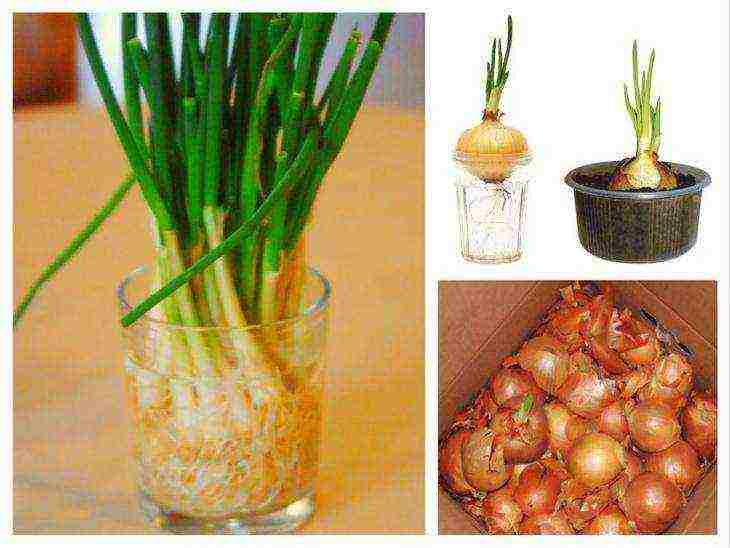
In the ground
Growing onions on a feather in the ground is not so difficult. The plant is rather undemanding to the soil, since the bulb itself contains the main supply of nutrients. It is advisable to use soil with neutral acidity, it is recommended to provide good drainage. There must be holes in the container so that the water can drain freely, and a tray where it will collect. The capacity must be chosen high enough. If there is not enough soil, the roots will push the bulb to the surface.
The optimal time for planting is January. To determine if the bulbs are ready for distillation, you can place one of them in a container of water. If the roots begin to grow actively, then it's time to start growing.

The peculiarity of the bulbs is that after planting they do not increase in size, but, on the contrary, dry out. Therefore, they can be placed next to each other. Onions are planted at home like this: first, a small layer of drainage, then a layer of soil at least 10 cm deep. There is no need to completely bury the bulbs in the ground, it is enough to do it by a third.
It is not recommended to put the bow on the window immediately after planting. It is better to choose a shaded corner, this will allow the root system to form successfully. After a few days, the containers should be moved to a well-lit area. The plant should now be getting enough sunlight. In winter, you need to use additional light sources: fluorescent lamps or special lamps sold in gardening stores.
You also need to take care of the temperature regime. Onions are quite cold-resistant, but they hardly endure the heat. At temperatures above 30 degrees, the bulbs will not release feathers. The optimum climate is 20-23 degrees.In winter, you need to make sure that it is not too hot on the windowsill due to battery operation. In summer, check whether the containers overheat under the sun. To avoid this, it is recommended to wrap the containers in foil.
The onion feathers on the windowsill, the cultivation of which requires minimal maintenance, will be juicy and tasty only if the plant receives enough moisture. It is better to water not too often, but abundantly. It is also allowed to spray greens with water from a spray bottle, but no drops should remain on the bulb itself.
In a plastic bottle
Home-grown onions are a nice addition to your daily diet. But there is not always enough space on the windowsill to arrange the required number of trays with sprouts. A regular plastic bottle with a volume of 5 liters or even more will help save space.
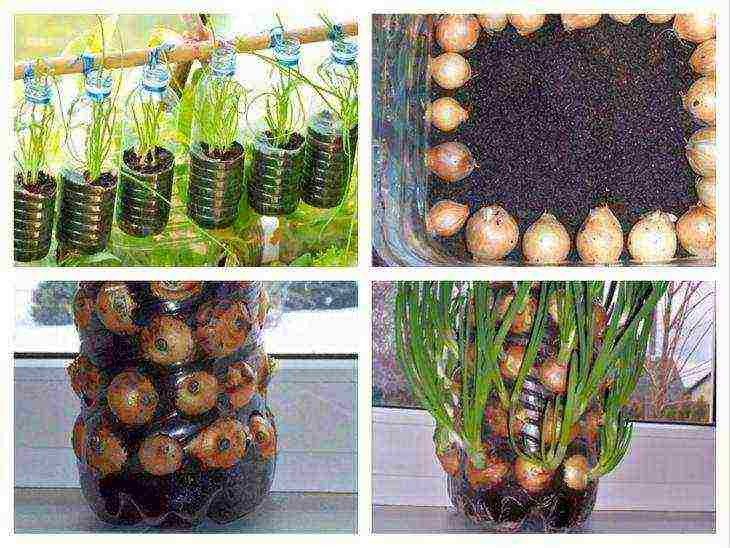
Onions in a bottle are planted in this way:
- Several rows of holes are made in the bottle. They should be slightly smaller than the bulbs to prevent them from falling out. In this case, you should not make the first row right near the bottom, otherwise the water will flow out.
- The bottle must be placed vertically. Fill up the prepared soil up to the first holes. Place the bulbs in the holes, cover with earth to the level of the next row. And so repeat several times until the bottle is completely filled. Now the plants need to be watered.
- The soil can be universal, and it is also allowed to use its substitutes. For example, mineral wool. It is only necessary to remember that all manipulations with it should be carried out with gloves, since this substance aggressively affects the skin. Other materials that retain moisture, such as sawdust and vermiculite, are also suitable.
Plants in a bottle on a windowsill grow well and give a bountiful harvest.
In a greenhouse from a bottle
An ordinary 5 liter bottle can be adapted into a mini greenhouse. It is necessary to cut off the foldable cover vertically, plant seeds in most of it.
In the package
You can use the growing method in the package.
In water
If there is a problem of how to grow green onions on windowsills in winter, then you should pay attention to the method in which no soil is used, but only water. Many people remember this method from childhood: an onion is placed in a jar of water, and after a few days it gives delicious feathers. However, in this case, you need to know some of the nuances.
So that fresh onions are constantly present on the table, it should be planted in batches at intervals of a week.
The main feature is that the bulb cannot be completely immersed in water, it will simply begin to rot. Only a small part, on which the roots are located, should come into contact with the liquid. To achieve this, you can take a very large onion or small jar so the planting material does not fall into. It is also allowed to make a hole in the cover.
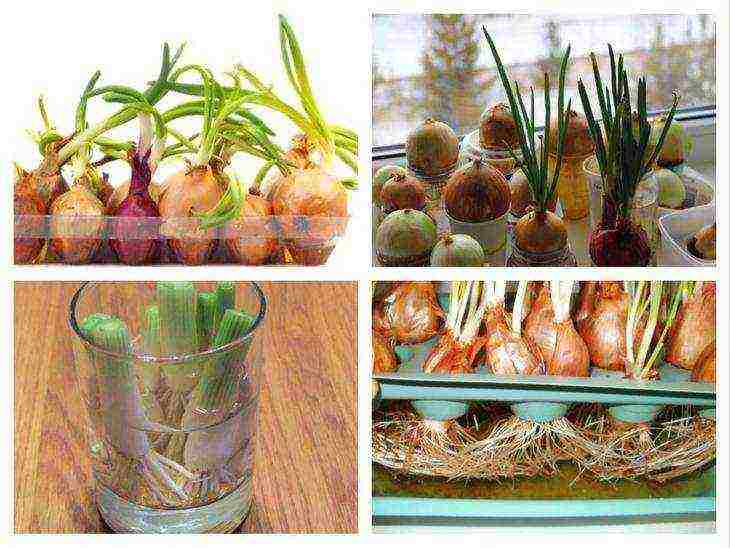
This is not to say that the string of cans on the windowsill looks very aesthetically pleasing, besides, the water in them becomes cloudy. It is more convenient to grow onions in winter in special containers; you can make them yourself. These containers include a water tray and a lid with holes. Bulbs must be placed in them.
In such a design, it is important not to forget to regularly change the water. It can be tap, only it must be allowed to settle first. Better yet, use an aquarium aerator.
How to grow chives
In addition to the usual onion, you can start growing chives on the windowsill. This plant has an unusual taste. It can be propagated vegetatively or with the help of seeds, with the second method being preferable. They do it this way:
- Soak the seeds before planting.
- A drainage layer is placed in a pot, then soil is poured. Chives do not have a developed root system, so the container may not be too deep.
- Next, you need to make shallow grooves and fill them with planting material.
- In order for the harvest to be rich, you need to take care of the planted seeds: water them, mulch with peat, fertilizing is also possible.
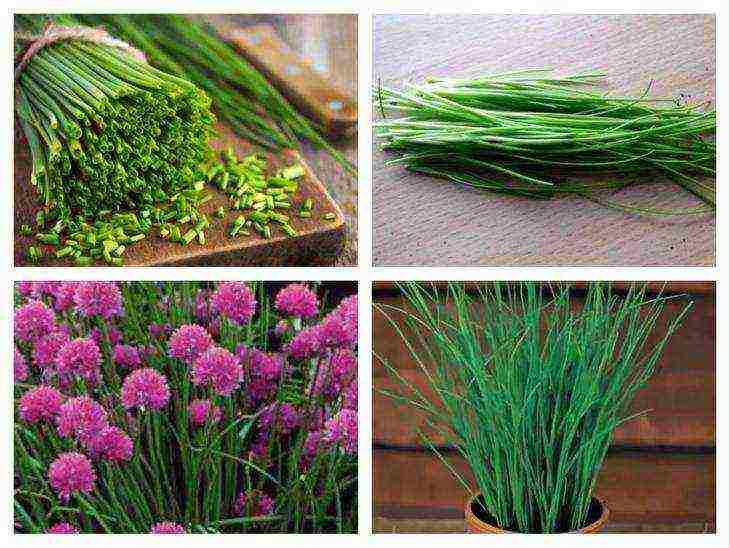
Chives If you are interested in how to grow chives, then you should know that this plant is perennial. It will harvest in the second year, in the first winter it will stand on the windowsill as an unusual decoration.
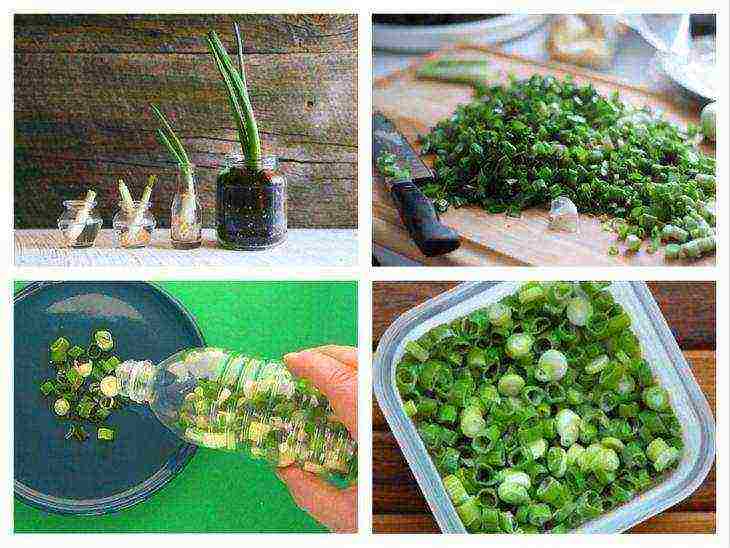
It is not difficult to figure out how to plant onions on greens on the windowsill. A little patience and a minimum of effort, and as a result, you can feast on a homemade onion. In a city setting, a self-grown vegetable will be a source of pride when it comes time to harvest. In addition, it will help maintain health.
